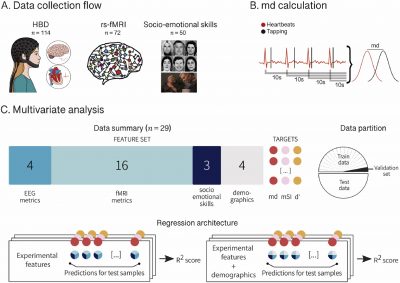03 de marzo 2020
Abstract:
Interoception (the sensing of inner-body signals) is a multi-faceted construct with major relevance for basic and clinical neuroscience research. However, the neurocognitive signatures of this domain (cutting across behavioral, electrophysiological, and fMRI connectivity levels) are rarely reported in convergent or systematic fashion. Additionally, various controversies in the field might reflect the caveats of standard interoceptive accuracy (IA) indexes, mainly based on heartbeat detection (HBD) tasks. Here we profit from a novel IA index (md) to provide a convergent multidimensional and multi-feature approach to cardiac interoception. We found that outcomes from our IA-md index are associated with –and predicted by– canonical markers of interoception, including the hd-EEG-derived heart-evoked potential (HEP), fMRI functional connectivity within interoceptive hubs (insular, somatosensory, and frontal networks), and socio-emotional skills. Importantly, these associations proved more robust than those involving current IA indexes. Furthermore, this pattern of results persisted when taking into consideration confounding variables (gender, age, years of education, and executive functioning). This work has relevant theoretical and clinical implications concerning the characterization of cardiac interoception and its assessment in heterogeneous samples, such as those composed of neuropsychiatric patients.


